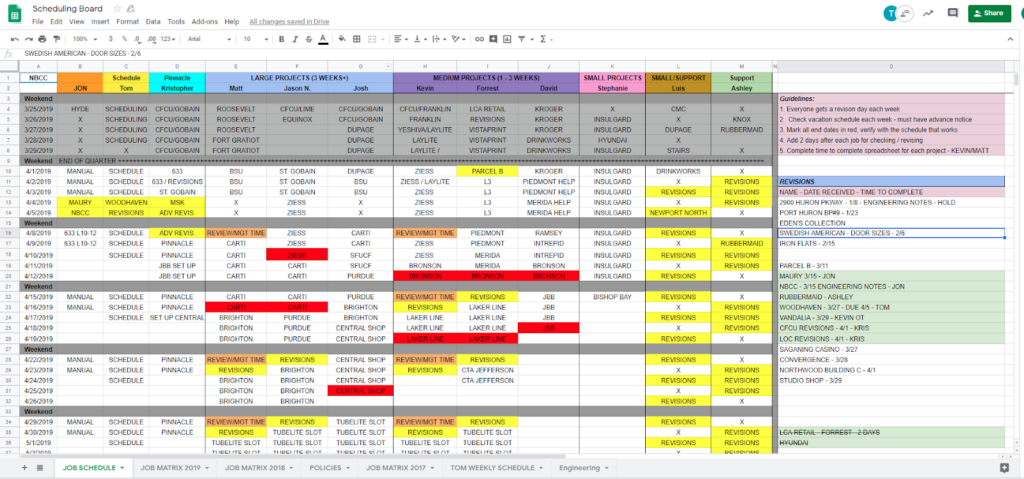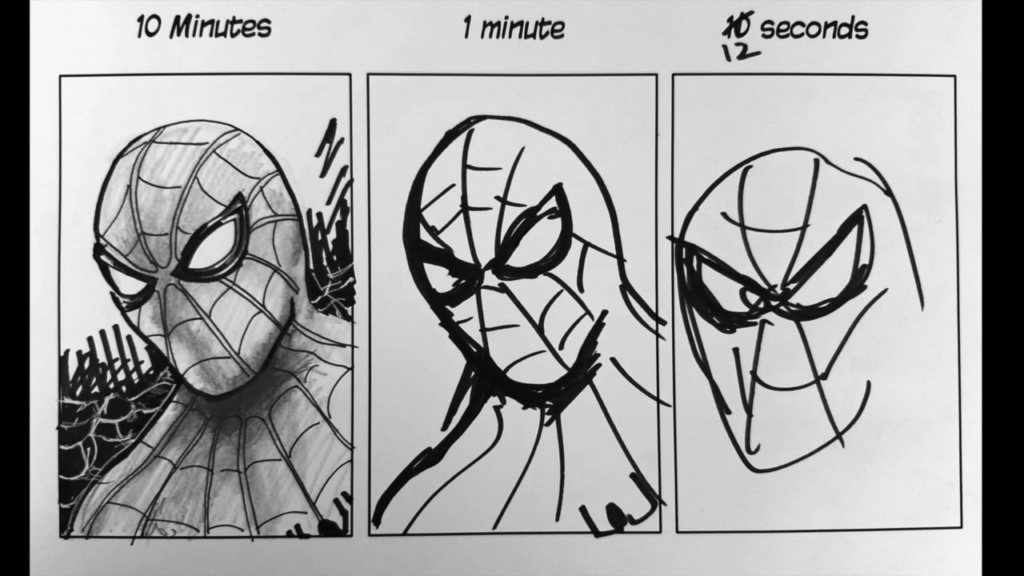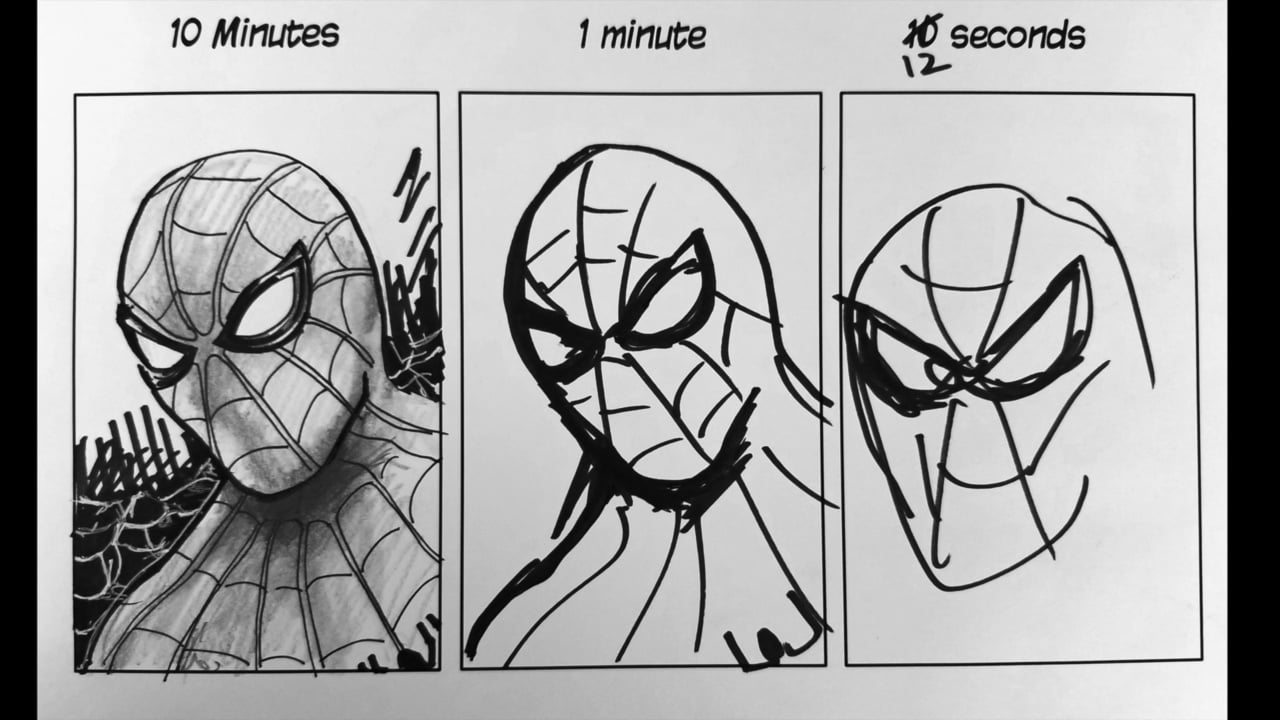Overcome Four Common Issues When Working with a Drafting Firm
Scheduling for construction projects isn’t an exact science.
Every experienced project manager knows that there are many factors that can catch you off guard and lead to delays. The reality is you can’t prevent every bottleneck. But you can at least prepare so you’re not blindsided when problems arise.
This article will help you anticipate and respond to common problems that arise in the drafting phase of a project. We’ll start by giving you an inside look at how a drafting firm operates, then we’ll share four common issues project managers face when working with a drafting firm — and how to overcome them. This should give you some insights that will help you work more cohesively with your drafting team.
Scheduling (from the perspective of a drafting service provider)
Here’s what our schedule looks like at MP Drafting:

It looks kind of messy, but there’s a method to the madness. We put a lot of time and effort into this schedule for a good reason.
As our company grew over the last 13 years (and especially over the last five years), we gradually came to the realization that we needed to have a very detailed schedule to organize our workflow. We also realized that we had to put somebody in charge of constantly updating the schedule and keeping the rest of us on track.
As you can see from the screenshot above, our schedule has a lot of moving parts. This is due to the challenges of managing a fairly large team. In theory, it would be ideal to make a plan, plug it into the schedule, and stick to the plan until project completion. We do our best to live up to this gold standard, but, in reality, our schedule changes almost daily. That’s why we set aside time every day to go over our schedule, revise it if necessary, and make sure everyone’s on the same page.
We’re still trying to find the perfect balance between risk management and efficiency: in other words, we try to leave enough time for project overages and unforeseen problems while keeping our project lead times as short as possible. The best way(s) to achieve this balance is a constant conversation in our office.
One of the strategies we came up with is to assign drafting professionals to “revision duty”. When a drafter is on revision duty, he or she works solely on requests for revisions as they land in our inbox. Once certain revisions are complete, the drafter floats around the office to help other drafters who either have revisions to complete or are behind on key deliverables.
But this strategy alone is not enough to head off all scheduling issues. Many issues need to be addressed by working closely with the project manager on the client’s side. The following four sections include suggestions to help project managers work closer with drafting service providers and keep projects moving on schedule.
Scheduling Issue #1: Estimated vs. Actual Lead Times
Let’s say you’re a project manager about to kick off a new project with us. You have a schedule to stick to so you need to know lead times for various parts of the project as early as possible.
While we try our best to give accurate lead times up front, the best we can do is give you a range that we feel is appropriate based on:
- Our current schedule and workload
- The complexity of the project
- Seasonal timing issues
However, if your project is delayed and we therefore aren’t able to start until a few weeks or months go by, we’ll have to review (and likely revise) the lead time we provided you up front. That means, unfortunately, that the construction start date for your project could get pushed back as well.
To help resolve this issue and prevent having to push back your project timeline, it would be a good idea to keep us updated on when you think the project may be landing on your desk. That way we can let you know whether the lead time we provided up front is still accurate, and we might even be able to slot your project into our schedule based on the projected release date you provided.
Scheduling issue #2: Drawings take longer than anticipated
Managing this issue is another balancing act: we want to give our drafters enough time to produce high-quality drawings, but we also want to minimize lead times for our clients.
There are a few common reasons why projects can take longer than expected:
- One or more highly requested drawings are highly complex
- Our clients provide new information late in the game
- The scope of the project changes due to architectural or engineering issues
There’s a much higher chance that we’ll deliver drawings on time if project managers provide us early on with completed kick-off forms and all important project information. If you anticipate a change to any aspect of the project, let us know right away so we can plan accordingly. We might be able to start one part of the project while waiting for your go-ahead on another aspect of the design.
As a side note: we do our best to review jobs as they come in, but we can’t be 100% invested in a project until one of our drafters has started working on it. That means we might send you questions three weeks into a four-week lead time, for example. In this case, it’s critical to get a response from you (the project manager) as quickly as possible.
Scheduling issue #3: Allowing enough time for a proper review
This is one of the biggest problems we face when scheduling a project.
We’ve worked with project managers who didn’t take the time to closely review our work. Instead, they assumed our drawings were correct and went ahead with construction, only to find out too late that there were issues with the drawings.
This isn’t because we got lazy and delivered poorly done drawings. There are many ways to produce engineering drawings. Your preferences might be different than another project manager’s or your installer’s. As a drafting firm that services over 100 clients, we do our best to accommodate the preferences of all our customers. But if, as the project manager, you don’t provide us with detailed guidance on what you need, there’s a good chance our drawings won’t be exactly to your liking. That’s why it’s critical to check our drawings promptly after we send them to you for review so we can provide you with timely revisions.
It’s also good practice to double check all drawings for accuracy in terms of part quantities, dimensions, finishes, and details. Never assume our drawings are 100% accurate. We recommend setting aside at least a full day to review drawings and additional time for us to revise them.
Scheduling issue #4: Rush jobs and overtime options
Sometimes you just have to get drawings done fast. We’ve all been there — it’s the nature of the industry. But quality is always sacrificed when speed is the first priority.

This is what happens when you rush a drawing. There’s no substitute for taking the time to get the details just right.
It’s always a good idea to give drafters the time they need to produce high-quality drawings. But if you have a job that absolutely needs to get done faster than our quoted lead time, please tell us as early as possible. We can provide you with options such as:
- Overtime work (at a premium)
- Moving jobs around (if you have multiple projects underway with us)
- Reviewing our schedule to see if any other project is set to wrap up faster than predicted
We might be able to get a drafter on “revision duty” to help accelerate your project toward early completion. But if we don’t have the capacity, we’ll let you know and provide you with a quote for overtime work. We’ll be honest so you know exactly what to expect in terms of timelines and costs.
Conclusion
At the end of the day, we want to help you be successful. That’s our most important job. And most of the time doing that job correctly comes down to communication. It’s as simple as that!
Most scheduling issues arise because of inadequate communication between project managers and drafting service providers. So make sure to check in regularly and don’t be shy about checking in with us for a status update. We’ll be happy to tell you how your project is progressing.

